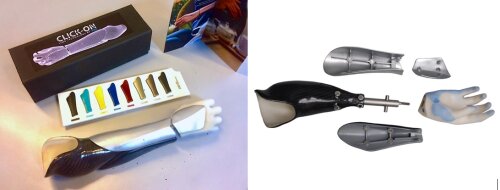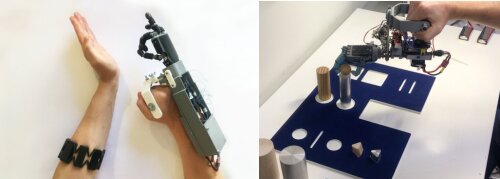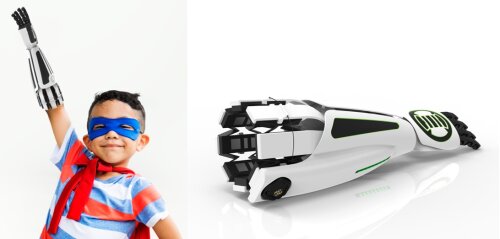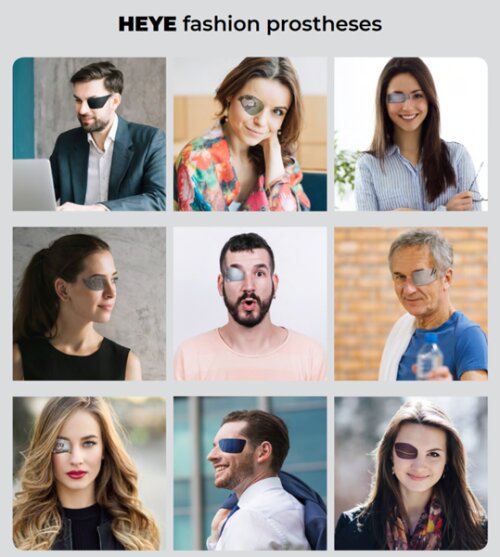Researchers: Julie Snykers, Gido Grooten, Erik Haring
Supervisors: Kristof Vaes, Verwulgen Stijn, Jan De Cubber
Orthopedic forearm prosthesis with personalized fairings
Although the idea of personalized fairings had been applied to leg prosthetics, this prototype was the first attempt to apply a similar design intervention to prosthetic arms.
Customizable medical devices, and prosthetic arm fairings, bring style and aesthetics to otherwise robotic prosthetics. Each fairing can be personalized with patterns, graphics and varying materials, in a sense, redefining the prosthetic as fashion statement and an expression of the patient’s personality. The prototype and the lessons learned during its development gave birth to a new range of prosthetic arms within het V!GO group, named the CL!CK-ON Limb Technology by V!GO.
The project is the result of a master thesis by master student Steven Renckens, in cooperation with UA promotor Kristof Vaes and industrial promotor Jan De Cubber (Centre for Craniofacial Epithetics, Member of the V!GO GROUP).

Multi-grasp myoelectric prosthetic hand for children
During this study, we focused on the physical realization of a multi-grasp myoelectric prosthetic hand for children from 6 years old. Through an iterative design and research process, several prototypes were realized that were subjected to a validated user test (SHAP-C).

Joyn One
The Joyn One, by Gido Grooten, is a fully 3D printed and EMG-controlled prosthetic arm for children aged 8 to 12 years. The Joyn One is developed to support prosthetic training. A digital platform, to which the prosthetic arm is linked, ensures that the child engages in a fun and playful way with the help of a linked avatar to perform the prosthesis training prescribed by the rehabilitation specialists on the basis of digital games.Each prosthesis is associated with a personal avatar or buddy that must be taken care of by the user. Taking care of this avatar can be done by correctly performing the prosthesis training.

HEYE fashion prostheses
Facial epitheses are unnoticeable from afar, but at a closer distance they risk being discovered. When bystanders notice the epithesis, they often react distressed or shocked. This reaction can be explained by the uncanny valley effect, which states that slightly imperfect humanlike objects evoke negative emotional responses. We present a design perspective that aims to stay away from the uncanny valley and creates a safe level of affinity by developing non-human like designs. Why can’t we present prosthetics as fashionable assets instead of realistic copies? Master student Julie Snykers conducted interviews with anaplastologists, orbital epithesis wearers, organized co-design workshops with orbital epithesis wearers and performed eye-tracking research on orbital epithesis prototypes. Although we have to remain mindful of negative associations, we believe that some of the hEYE design prostheses were capable of projecting a stronger, more confident look for orbital epithesis wearers.

Funding: BOF STIMPRO 2016 / Master thesis Design Research
Period: 2016-2018
Partners: Centre for Craniofacial Epithetics, Member of the V!GO GROUP